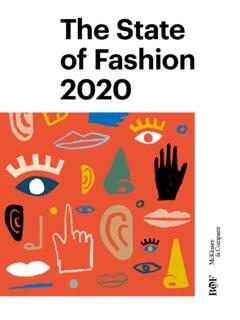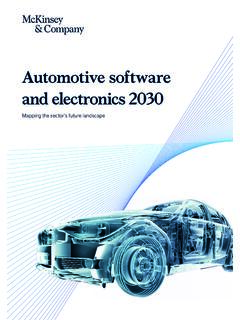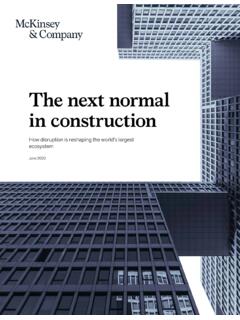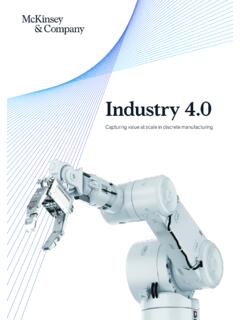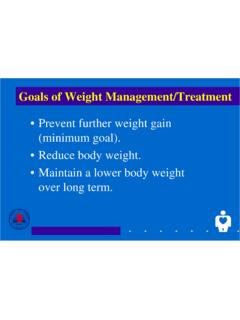Transcription of Can HVAC systems help prevent transmission of COVID-19?
1 Advanced Electronics PracticeCan HVAC systems help prevent the transmission of COVID-19? Modifications to heating, ventilation, and air-conditioning systems might help reduce the spread of the novel coronavirus by purifying air, improving ventilation, and managing 2020 4FR/Getty ImagesThis article was written collaboratively by the Advanced Industries Practice. The authors include Stephanie Balgeman, Ben Meigs, Stephan Mohr, Arvid Niem ller, and Paolo much remains unknown about COVID-19, scientists have established that the coronavirus is highly contagious and transmitted via air.
2 Studies suggest that it primarily spreads when infected people cough, sneeze, or talk actions that expel respiratory droplets containing particles of coronavirus in combination with mucus or saliva. If these droplets land on or are inhaled by others nearby, they could transmit the Touching doorknobs, computer screens, or other surfaces on which droplets have landed may also lead to infection. The now-common guidelines for wearing masks and physical distancing typically, by remaining six feet away from others reflect these observations.
3 Questions remain, however, about whether tiny coronavirus particles, of about microns in size, can become airborne and travel greater distances. Although heavy droplets, of about five to ten microns, usually travel less than one meter before settling, smaller droplets may evaporate, leaving virus particles, referred to as aerosols, suspended in the A recent study demonstrated that coronavirus particles may be active for up to three hours after their Although the World Health Organization (WHO) initially held that the coronavirus could not be spread through aerosols, it recently reversed its stance.
4 The WHO guidelines now state that airborne transmission of the coronavirus may be possible indoors, especially for people who spend extended periods in crowded, poorly ventilated The WHO s turnaround came after the organization received an open letter from 293 scientists asking the organization to reconsider its position on airborne Given the concern about airborne transmission , building managers, safety experts, and others might take steps to optimize ventilation and airflow indoors and limit viral spread. Some simple moves may help (see sidebar Low-tech strategies for 1 World Health Organization, Q&A on Coronaviruses (COVID-19), April 17, 2020, Michele Debczak, Airborne vs.)
5 Aerosol vs. droplet: What s the difference? Mental Floss, April 14, 2020, Neeltje van Doremalen et al, Aerosol and surface stability of SARS-CoV-2 as compared with SARS-CoV-1, New England Journal of Medicine, March 17, 2020, Q&A: How is coronavirus transmitted?, World Health Organization, July 9, 2020, Apoorva Mandavilli, 293 experts with one big claim: The coronavirus is airborne, New York Times, July 4, 2020, strategies for preventing airborne viral transmissionIn localities that have reopened, busi-ness leaders, school officials, and others have already taken many steps to make their facilities safer.
6 Some have installed physical barriers, made corridors one- way, increased the frequency of cleaning, and widened the space between desks. Staggered shifts are now common at many companies to decrease physical distanc-ing, and masks are often mandatory. Other simple steps that may prevent airborne transmission include the following: rearranging furniture to avoid having several people on the same airflow corridor opening windows in buildings with basic HVAC systems , which cannot filter or pull in outside air, to increase the exchange of fresh air locking windows in buildings with central HVAC systems , when permissible, to reduce indoor temperature changes.
7 If a fan does not have to increase its speed because of an inflow of warm or cold air, turbulence will remain low designing novel seating arrangements, such as having employees on a shop floor work back-to-back rather than face-to-face limiting the number of people allowed in a room replacing hand dryers with paper towels to reduce air turbulence2 Can HVAC systems help prevent the transmission of COVID-19? 6 There are two main types of HVAC systems . Ductless ones heat and cool air directly in rooms. systems with a central duct can move outside air into buildings.
8 This section focuses on systems with central Ignatius TS et al, Evidence of airborne transmission of the severe acute respiratory syndrome virus, New England Journal of Medicine, April 22, airborne viral transmission ). But this may also be a good time to think about improving air quality in buildings by significantly changing heating, ventilation, and air-conditioning (HVAC) systems or by making physical changes to manage indoor changes and upgrades to HVAC systemsHVAC systems6 can potentially spread a virus across rooms when high-speed air flows past an infected person to others, something that has been shown with Severe Acute Respiratory Syndrome in If airborne transmission is also possible with the coronavirus, a few control-setting changes and upgrades may help decrease the risk of spread through this route.
9 If building managers take such actions, they might help their tenants feel more comfortable amid all the uncertainty about the coronavirus (see the sidebar Earning the trust of tenants ). One step that technicians could take involves configuring ducted HVAC systems to increase the rate of exchange with fresh fresh air from outside the building to reduce recirculation. Adjusting the settings may also help. Instead of shutting down overnight or on weekends, for instance, the HVAC system could run without interruption to increase the replacement of air and minimize airflow buildings with old or inflexible systems , technicians might consider upgrading HVAC hardware.
10 Some of the most important might include these: replacing fixed-speed fan motors with variable-speed ones to enhance the control of airflow and allow for a minimum setting that produces lower speed airflow introducing sophisticated airflow-control systems , such as those that are sensitive to pressure, to allow for smoother adjustment of airflows installing high-performance air-purification systems , as discussed in the next sectionOptions for air purificationNumerous technologies can purify air. Filtration is the most common and typically the most effective method for HVAC systems (Exhibit 1).


